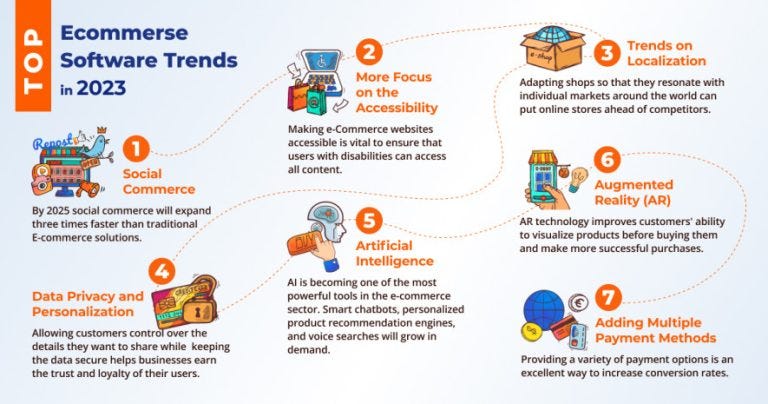
Navigating E-commerce’s Latest Digital Trends for Success
The landscape of e-commerce is continually evolving, shaped by technological advancements, changing consumer behaviors, and emerging trends. Staying ahead in this dynamic environment is crucial for businesses looking to thrive in the digital marketplace. This article explores key E-commerce Digital Trends that are reshaping the industry and offers insights on how businesses can leverage these trends for success.
1. The Rise of Mobile Commerce
As smartphones become increasingly ubiquitous, the rise of mobile commerce is a defining trend in the e-commerce landscape. Consumers are opting for the convenience of shopping on their mobile devices. Businesses must prioritize mobile optimization, responsive design, and user-friendly interfaces to cater to the growing mobile-centric consumer base.
2. Personalization and Customer Experience
E-commerce platforms are embracing personalization to enhance the overall customer experience. Tailoring recommendations, personalized marketing messages, and customized user interfaces contribute to a more engaging and satisfying shopping experience. Utilizing data analytics and artificial intelligence, businesses can understand individual preferences and deliver targeted content.
3. Augmented Reality (AR) for Virtual Shopping
Augmented Reality is revolutionizing the e-commerce experience by enabling virtual shopping. Consumers can visualize products in their own spaces before making a purchase. This immersive technology bridges the gap between online and in-store shopping, providing a unique and interactive way for customers to explore products.
4. Voice Commerce Integration
The growing popularity of virtual assistants and smart speakers has given rise to voice commerce. Integrating voice-activated technology into e-commerce platforms allows customers to make purchases using voice commands. Optimizing product listings and checkout processes for voice search enhances accessibility and caters to the emerging trend of hands-free shopping.
5. Sustainable and Ethical E-commerce Practices
Consumers are increasingly prioritizing sustainability and ethical practices when making purchasing decisions. E-commerce businesses are responding by incorporating eco-friendly packaging, transparent supply chain practices, and sustainable product options. Aligning with these values not only attracts conscious consumers but also contributes to positive brand perception.
6. Social Commerce and Shoppable Content
Social media platforms have become more than just marketing channels; they are now integral to the e-commerce experience. The rise of social commerce involves making products directly purchasable on social media platforms. Shoppable content, including interactive posts and live shopping events, provides a seamless transition from discovery to purchase.
7. Subscription E-commerce Models
Subscription-based e-commerce models continue to gain momentum. Offering products or services on a subscription basis provides businesses with a predictable revenue stream and fosters customer loyalty. From subscription boxes to digital services, this model appeals to consumers seeking convenience and personalized experiences.
8. Artificial Intelligence for Enhanced Decision-Making
Artificial Intelligence (AI) is playing a pivotal role in optimizing various aspects of e-commerce, from demand forecasting to personalized recommendations. AI-powered chatbots and virtual assistants enhance customer support, providing instant assistance and streamlining the buying process. Harnessing the potential of AI contributes to operational efficiency and improved decision-making.
9. Seamless Checkout Experiences
Reducing friction during the checkout process is a constant focus in e-commerce. Trends include one-click checkouts, digital wallets, and payment options that prioritize security and convenience. Streamlining the checkout experience minimizes cart abandonment rates and ensures a smoother path to conversion.
10. Data Security and Privacy Compliance
As e-commerce transactions increase, so does the importance of prioritizing data security and privacy. Customers are more conscious about how their data is handled. Implementing robust cybersecurity measures and ensuring compliance with data protection regulations builds trust with consumers and safeguards the reputation of e-commerce businesses.
In conclusion, navigating the ever-changing landscape of e-commerce requires a proactive approach to embrace and adapt to emerging digital trends. By staying informed and implementing strategies aligned with these trends, businesses can not only survive but thrive in the competitive world of digital commerce.
For further insights into E-commerce Digital Trends, explore E-commerce Digital Trends. Stay ahead of the curve to ensure your e-commerce success in the digital era.




